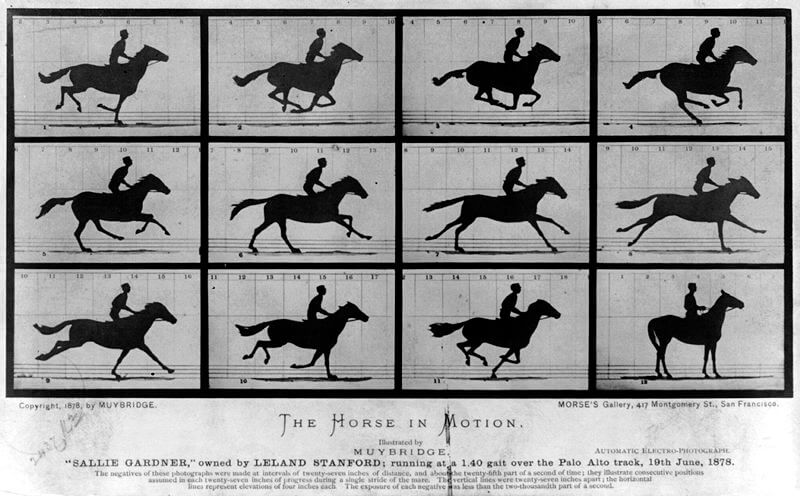How did Muybridge's talent for photography (and the money that went with it) help save Muybridge from being charged with murder, and do horses lift all four legs when they gallop?

Edward Muybridge Eadweard Muybridge, 1830-1904 was born in England as Edward James Muggeridge (Muggeridge and adopted the abbreviated surname Muybridge as a temporary nickname. He immigrated to San Francisco in his twenties and focused on publishing books.
However, at the end of the 19s, a carriage accident left him seriously injured, and he returned to England to rehabilitate. While he managed to recover physically, his personality became eccentric which was reflected in his behavior.
While in England he became familiar with photography and became addicted to it. He returned to San Francisco in the mid-sixties and reinvented himself as a Muybridge photographer. He specialized in landscapes and architectural objects and gathered a reputation and fans for his breathtaking reproductions of Yosemite Park. These photographs brought him a contract with the government to photograph the new territories in Alaska and he expanded his work to other sites in the West. Thanks to this developing career, he was able to shape an identity for himself. He also changed his name to "Eadweard Muybridge."
Muybridge met with Leland Stanford, former governor of California and president of the Central Pacific Railroad, as well as a horse breeder. He sought Muybridge's help in settling a popular dispute among the horsemen. Stanford believed that at some point, when the horse gallops, all four of its legs are in the air at the same time, but he did not know how to prove it. Stanford offered a $25 reward to motivate Muybridge to provide the answer, which Stanford wanted quickly.
At that time Muybridge had other worries, he caught his wife in an affair with Captain Harry Larkins, which resulted in the birth of her son, who he thought was his son. He arrived at the officer's house and shot him dead. Despite this, he claimed memory due to the brain injury - thanks to his connections with Stanford, he had money for a good lawyer. However, the court did not accept his plea of insanity. However, the jurors claimed that it was a justifiable homicide, and thus he was spared punishment.
After the trial, Muybridge worked for a while in Central America before returning to the collaboration with Sanfrod. In 1877, Muybridge took a unique photograph that proved that horses do lift all four legs for a brief moment when galloping. Unfortunately, however, the negative of the image was lost.
Stanford was a determined man, and he insisted on more strong evidence. Muybridge rose to the challenge again. He placed a series of cameras along a track to cover the entire distance a horse makes at a gallop. Each camera also contained a wire that connected to a circuit breaker that was driven by the horse's hooves.
The series of photos was called "The Movement of the Horse" and it proved that Stanford's feeling was correct. All four hooves were in the air at the same time, but not when the legs were fully extended back and forth as shown by most paintings that attempted to illustrate the movement of the horse. Instead, the horse is in the air with all four legs under the body and the weight is transferred from the front legs to the hind legs.
To see the images, Muybridge created a device known as a zoopraxiscope, a strip of successive images was placed on a rotating glass disk and could be viewed through a slit. The alternation of the images caused them to merge in the viewer's mind and thus gave them a sense of movement. In 1880 after a journalist saw a demonstration of the zoopraxiscope, he wrote about it in the San Francisco Voice "the feeling was as if we were looking at a flesh and blood horse".
Muybridge's photos were published and he went on a series of lectures in the US and Europe. His curiosity didn't stop with horses, and he replicated the technique of taking sequential images to capture movement and document moving humans and animals in a variety of ways.
Muybridge's invention inspired Thomas Edison, who holds the patent for a camera that takes moving pictures - or the first motion picture camera, Philip Glass, who in 1982 wrote an opera based on Muybridge's murder trial, and the piece "Lemon" by U2 ("A man takes a picture, a moving picture , through the projected light he can see himself up close"), as well as the effect of shooting the bullet in slow motion in the movie Matrix.
The history of photography Part II Can horses fly? By Ran Levy

9 תגובות
He asks if you want it in pita or in lafa?
Nice caption.
What it means?
Today (April 9) is the anniversary of the birth (in 1830) of the talented photographer.
Therefore, whoever opens Google will be able to see (on the opening page) the clip consisting of the horse's images. You should click on the play arrow.
Thank you Yair.
Editing the site and carrying the torch of the scientific update deserve all the praise.
Quill discharges are not a cause for grief.
If so, then the source misled me because I checked what I was writing, even at two in the morning.
The governor of California is called Stanford - not Sanford.
The prestigious Stanford University was later founded in his name.
Stanford later published the study - without any credit to Muybridge
See for example:
http://en.wikipedia.org/wiki/Leland_Stanford
thanks for the correction.
He was injured in an accident and returned to England in the late 50s, not in 1850 as written in the article.